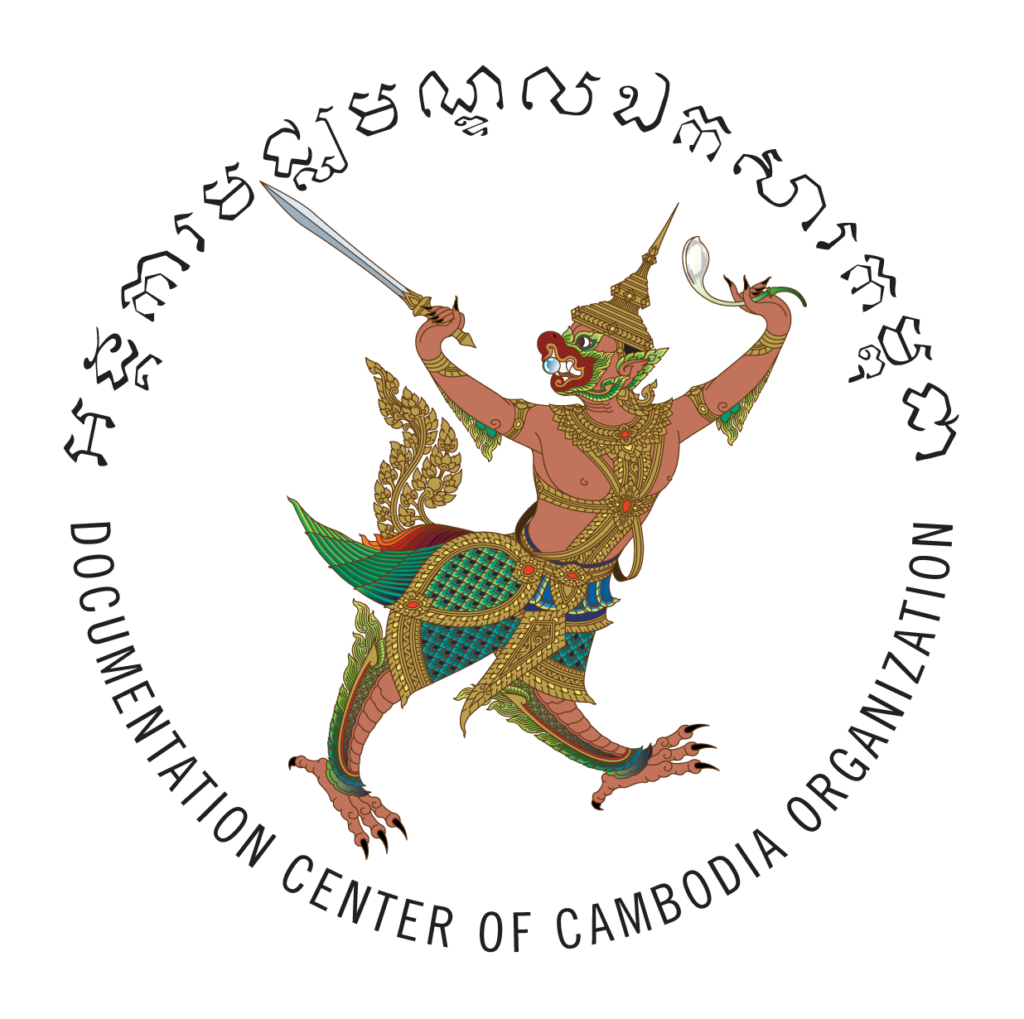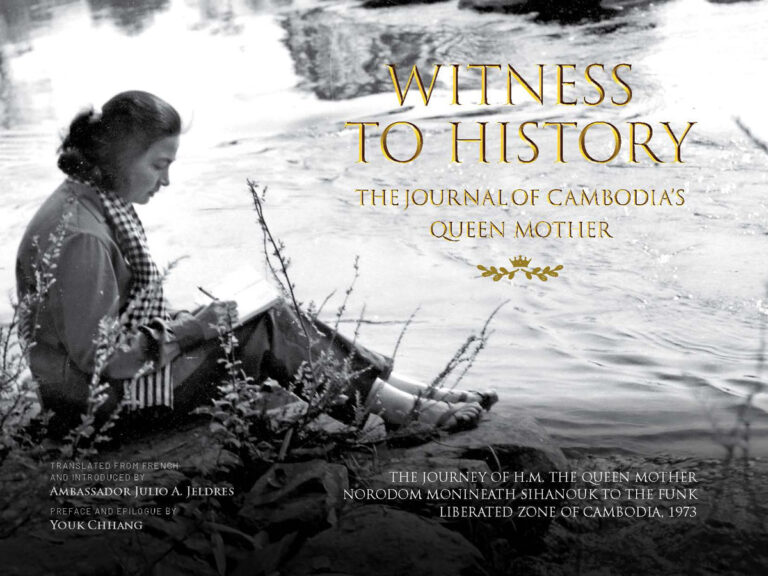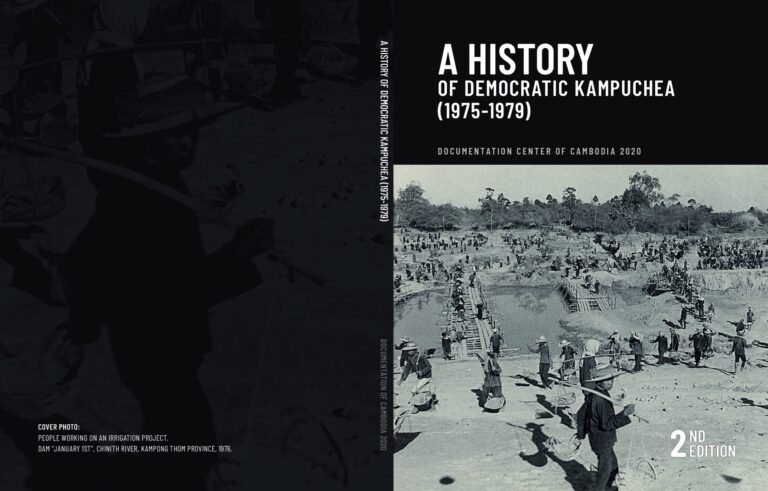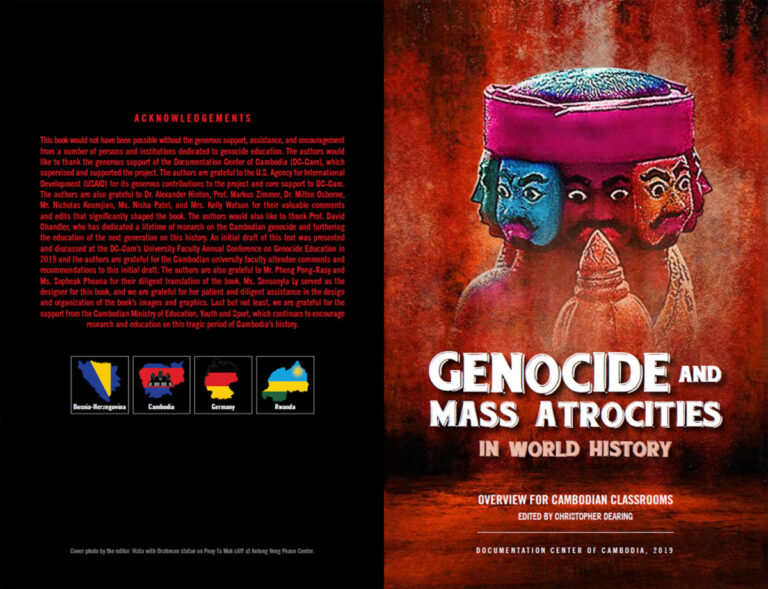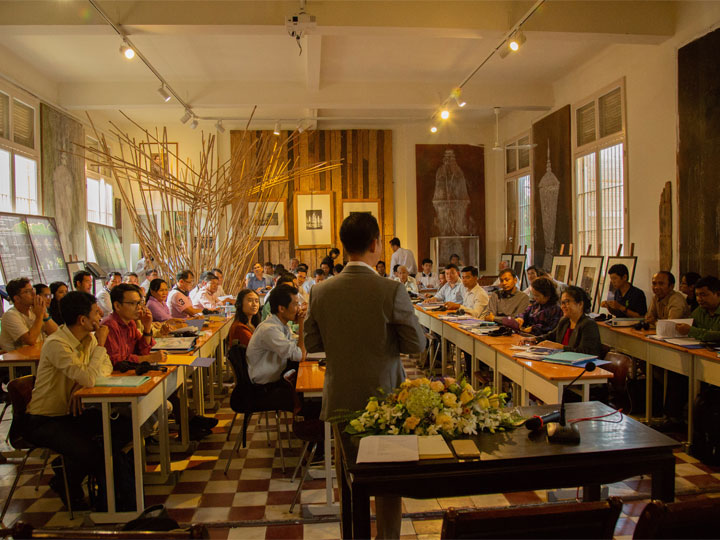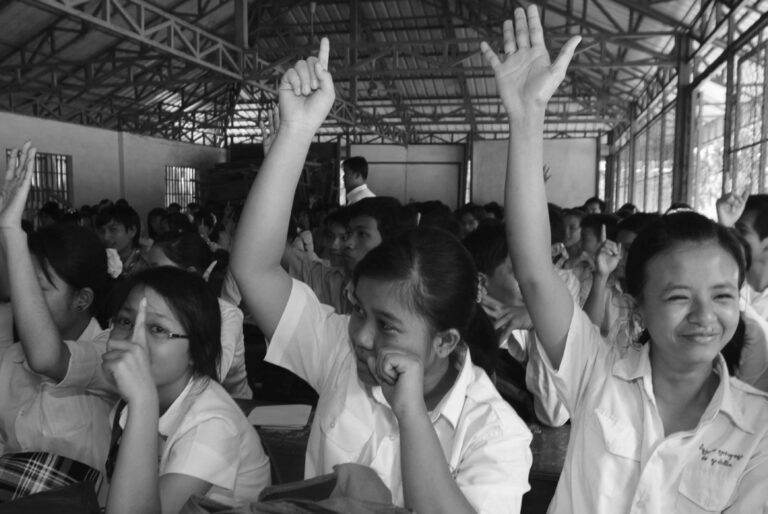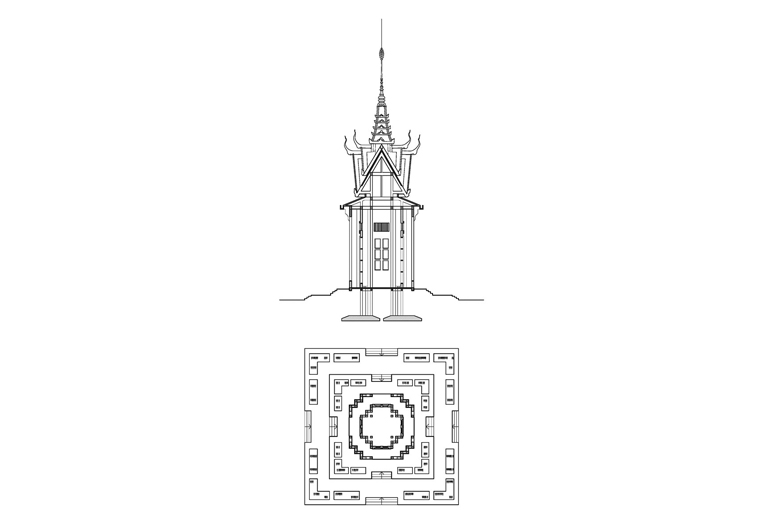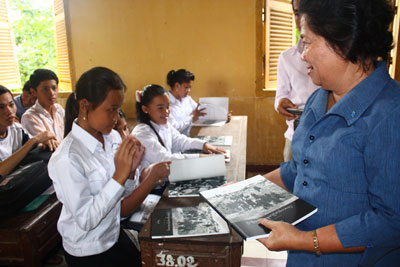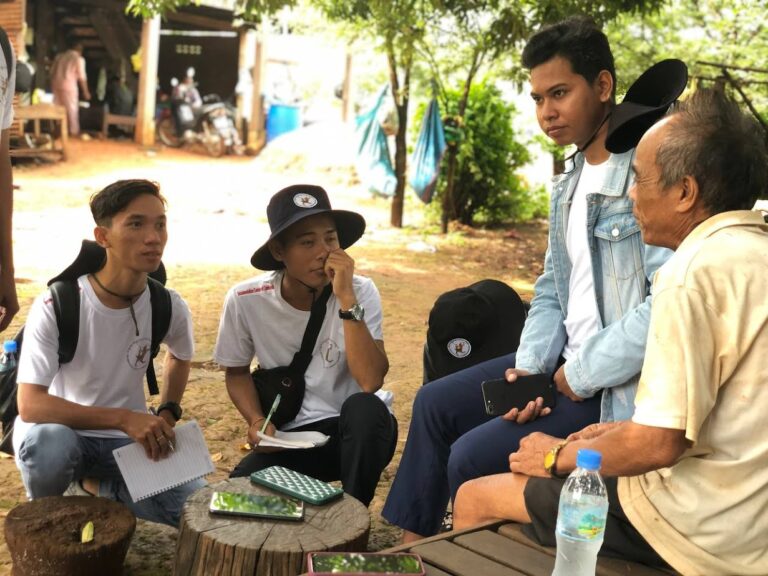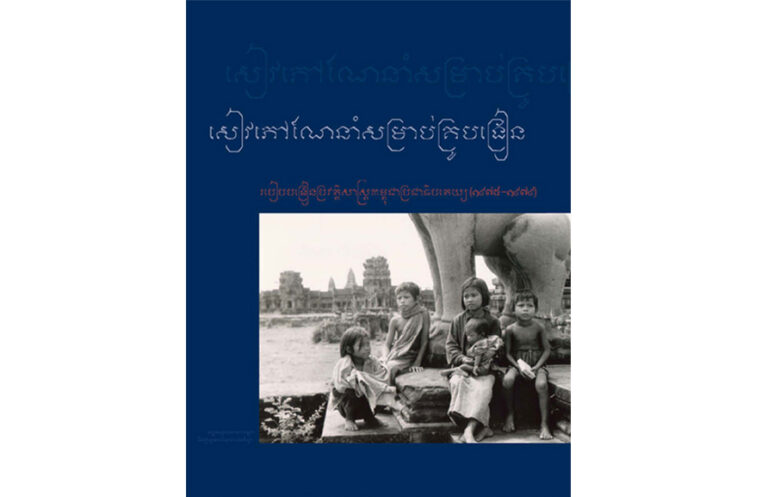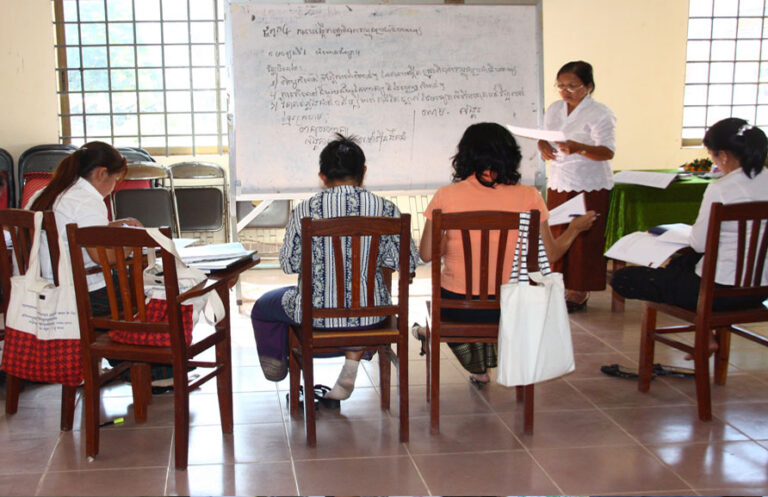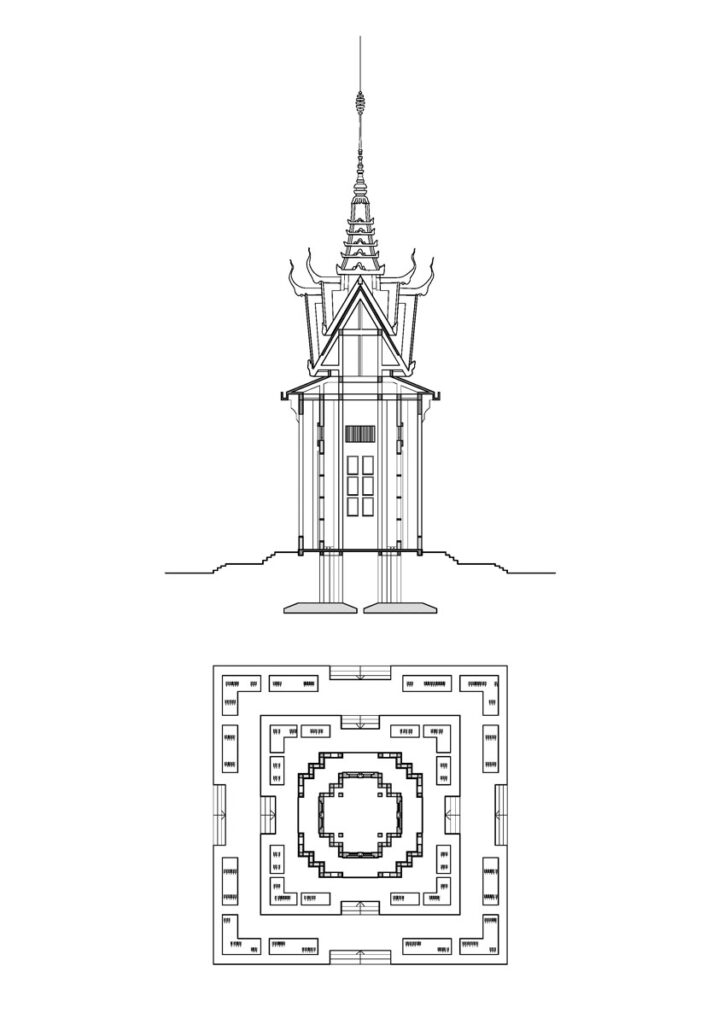
Memorializing a tragedy where millions died need not cost millions, thousands, or even hundreds of dollars; nor does the memorial have to be a museum, an imposing monument, or even a symbolic statute. Moreover, the location of the memorial does not have to be on spacious open greenery or a newly created platform. A powerful memorial can take the form of a simple slogan hung outside a local school. When such banners are hung across every high school in the country so that school children, parents, community members, and passersby read their message, then the collective impact of these banners can be more powerful and wide-reaching than even traditional memorials.
This is the hope of the Documentation Center of Cambodia (DC-Cam), which on June 17 received approval from the Ministry of Education to hang anti-genocide slogans across all 1,700 high schools in Cambodia. These banners contain two slogans that both memorialize the tragedy of Democratic Kampuchea and promote post-genocide reconciliation. They read: (1) “Talking about experiences during the Khmer Rouge regime is to promote reconciliation and to educate children about forgiveness and tolerance;” and (2) “Learning about the history of Democratic Kampuchea is to prevent genocide.” The estimated cost of one banner is approximately $40. One banner containing both slogans will be hung in each school, with the location to be determined by the respective school. Possible locations for the banner include the front wall of the school building, near the school’s flag pole, or in front of the school yard or garden.
DC-Cam hopes that the two slogans will serve as a “genocide educational memorial” to Cambodia’s tragedy that claimed nearly two million lives from 1975-1979. These slogans complement DC-Cam and the Ministry’s current multi-stage nationwide Genocide Education Project that began in 2005. Thus far, the project has published the first-ever textbook on Democratic Kampuchea (A History of Democratic Kampuchea (1975- 1979) by Dy Khamboly), a Teacher’s Guidebook, and a Student Workbook; conducted a national teacher training workshop led by well-known international and Cambodian scholars and experts; and implemented provincial and local teacher training workshops throughout the country. Nearly all of Cambodia’s 24 cities and provinces have conducted these local trainings with Battambang, Kampong Cham, Kampong Speu, Kandal, and Phnom Penh midway in their trainings. This summer, DC-Cam began the next phase of the project- evaluating local high school teachers as they teach the history of Democratic Kampuchea to students in their classrooms. These two slogans, though seemingly inconsequential when compared to the first ever textbook on Democratic Kampuchea or a historic national teacher training involving dozens of renowned genocide experts, are in fact just as profoundly important and meaningful to post-genocide reconstruction and prevention as any other initiative.
INTRODUCTION
On November 14, 2018, Documentation Center of Cambodia (DC-Cam), in collaboration with the Ministry of Education Youth and Sport (MoEYS), held a commemorative event at Samdech Chakrei Heng Samrin Anlong Chrey high school in Anlong Chrey Village, Kakk Commune, Ponhea Krek District, Tbaung Khmum Province, to mark the unveiling of a genocide education memorial and distribution of school textbook on the history of Democratic Kampuchea (DK) and other Khmer Rouge-related document. This was 26th genocide education memorial to be installed and inaugurated in secondary school level across the country. The construction of the memorial was funded by Chino Cienega Foundation. The event was presided over by Her Excellency Ton Sa Im, Undersecretary of State of the Ministry of Education Youth and Sport, Mr. Ka Vachana, Deputy Head of Tbaung Khmum Provincial Education Office, also participated as a guest of honor. Speeches also given by Mr. Pheng Pong-Rasy, Director of DC-Cam’s Prey Veng Documentation Center and Genocide Research and Education in Cambodia. The event closed with a question-and-answer session between students and Mr. Pheng Pong-Rasy, followed by the distribution of textbooks.
The purpose of this report is to explore activity of an opening ceremony of inauguration of two panels of anti-genocide slogans which were installed in a compound of a high school nearby Cambodia-Vietnam border and to understand participants’ knowledge of the slogans and their opinions of the built slogans in an effort to fill a gap in the education of Cambodia’s youth on the nation’s history of human rights abuse and the importance of tolerance, reconciliation and education for the future.
History of Anlong Chrey
Anlong Chrey is hometown of National Assembly President Heng Samrin. Last 7 years, Anlong Chrey and Thlok Trach villages were climbed to be part of Vietnam territory. Not many people living in these villages at that time. His Excellency Va Kimhong, former senior minister in charge of the Cambodian Border Affairs Committee, was quoted by local Newspaper, saying that the government would have to compromise to keep Thlok Trach and Anlong Chrey villages, as part of the border demarcation process. “We have still kept both the villages the same, but we have an obligation to find any area in Kampong Cham province to give back to Vietnam.” In a reply to H.E. Va Kimhong, Sean Peng Se who was president of the NGO alliance Cambodia Border Committee said from France and the Phnom Penh Post cited that any exchange would be unacceptable without consulting those who stood to lose land from such a deal.
Recently, many people come to live in Anlong Chrey and this population increases every year. According to a village chief, most of them come from nearby provinces such as Svay Rieng and Prey Veng. Nowadays, some most beautiful buildings have been built and at least hundreds houses have already been built for people. The Village chief said that these buildings are at along border of Cambodia-Vietnam. Some villagers added that the houses have been given to people to live and that they will protect the border from invasion of Vietnam.
Reported by a local newspaper, Daem Ampil, writing that Anlong Chrey used to be a place where a movement of Anti-Khmer Rouge was formed in late 1970s. Mr. Heng Samrin said 24th May that the anti-Pol Pot movement was formed in Anlong Chrey village, Kok commune in Ponhea Krek district of Kampong Cham province in 1977. According to Heng Samrin, Anlong Chrey was a target of American bombing during Lon Nol regime to destroy Khmer Rouge (Khmer liberation) movement in early 1970s and a place where a movement of anti-Khmer Rouge was created to fight against the Khmer Rouge regime in late 1978. On a speech on 24th May, Heng Samrin said that Anlong Chrey was a village which received the heaviest destruction during the American bombings that killed 12 villagers, a historical birthplace of the “United Front for National Salvation” and a significant base of the anti-Pol Pot movement where many nationalist leaders were based. He said: “Anlong Chrey is a village where all the anti-Khmer Rouge forces gathered and planned their strategy to topple the Khmer Rouge regime. The creation of the armed movement in order to form a “national front” was supported by the people from Anlong Chrey to as far as Snuol district. After the armed movement was formed, there was a universal declaration of the creation in Snuol district (of the United Front for National Salvation of 2nd December, 1978).”
METHODS
The inauguration ceremony was held at 8 a.m. with about two hundred participants which was students, teachers, school principal and high education officials from Ministry of Education Youth and Sport (MoEYS) and Provincial Office of Education. First, a speech by deputy director of Tbaung Khmum Provincial Office of Education Mr. Ka Vachana was read to the participants, reporting overall education sectors around the province. Number of teachers, students and schools were mentioned in order to give detail information to Her Excellency Tun Sa-im as well as presented participants.
Second, Mr. Pheng Pong-Rasy, director of DC-Cam’s Prey Veng Documentation Center and Genocide Research and Education in Cambodia, spoke to the participants a purpose of installing the anti-genocide slogans, along with brief explanation of the Prey Veng Documentation Center’s activities in 2019 and some projects of the Genocide Research and Education in Cambodia.
Third, H.E. Tun Sa-im came to the stage and talked more about the most recent education system in Cambodia and explained the two slogans meaning to the participants. At the end of her speech, she proposed all history teachers in Anlong Chrey high school to join DC-Cam’s village history project which has been working since last year and continue to another 5 years ahead. She also thanked to DC-Cam for working on the installation of the anti-genocide slogans at not only at Anlong Chrey high school, but more schools in Cambodia.
Fourth, the officially opening the curtain covering the slogans was made by H.E. Tun Sa-im, along with DK textbook and other Khmer Rouge-related document were distributed to all participants.
Next, Q&A session was openly discussed. At the beginning of this event, a presentation of every chapter of DK history from the DK textbook were summarized to the participants. This was about half an hour. After that more questions were asked by the students. All the questions were answers.
Last, 24 survey sheets were distributed to 24 selected teachers and students. The survey contains 7 questions. The questions are not multiple choice questions, but open-ended questions. The purpose of the survey is to explore students and teachers’ knowledge on the slogans and their reflections to the slogans. Please read the answers to the questions in “Result” section.
The Ceremony was finished successfully with very well organized. All attending participants stayed with the ceremony from the beginning until the end of every activity. Some teachers who attended the Ceremony said that they gained more knowledge about the Khmer Rouge history through the presentation of this history. Some added that the slogans will help them in teaching and will become a guide for students to create a space for their conversation with families at home after school. The school principal, Mr. Horn, was happy with this program. Using this slogans, he will encourage his teachers to let the students to read, think and analyze the slogans.
RESULT
13 teachers and 11 students were random selected to fill the survey. The survey contains 7 questions. Inside the office of school principal was used as a place for filling the survey, while the outside office was chosen to be a space for students to work on the survey. Respondents spent more than 30 minutes to fill in the survey and then they gave the survey to us before they went home at 11:20 a.m. on the same day.
The 7 questions were detailed below, and the answers from both teachers and students were typed under each question.
1. Have you heard about Khmer Rouge regime before you join the Ceremony?
All 24 said “yes” to this question with some explanations. Because most of the teachers who filled in the survey were born after the Khmer Rouge regime, they said same as their students that they know this history from their parents, grandparents, communities, schools, news and other social medias.
2. Are you satisfied with this anti-genocide slogans installation at your school?
All said “Yes”. There is no explanation to this question.
3. Please explain how can this installation of the anti-genocide slogans help you?
⦁ Understand the Khmer Rouge history and feel pity to the lives of people under this regime.
⦁ Encourage [people or students or teachers] to remember what happened during the past and prevent the atrocity during the Khmer Rouge [regime].
⦁ Serve as an evidence for students to believe what happened in the past in Cambodia and encourage them to study hard of their own history in order to build the country away from genocide.
⦁ Serve as a message to the students to build unity, reconciliation, and tolerance. The study of this history is to prevent this history happening again in the future.
⦁ Understand the leadership of Khmer Rouge and will never teach students how to follow this leadership. This serves as an experience that every leader has to learn in order to lead the country away from genocide.
⦁ The slogans train the younger generation to love nation and country.
⦁ This serves as an additional teaching materials while teaching this history with students.
⦁ This encourages me to search more information about this history so that I can use the finding as my teaching material with the students.
⦁ Become a slogan that encourage students not to create an environment of discrimination against each other.
⦁ Remind me of what happened in the past and this slogan is to educate younger generation to tolerance and prevent this regime happening again in the future.
⦁ This slogan helps younger generation to build social unity and reconciliation and to speak about this regime.
⦁ Help me to understand more about Khmer Rouge history.
⦁ From this slogan, I understood that the lives under Khmer Rouge regime were so difficult.
⦁ Encourage me to study more and more about this history and push me to do more research on this history.
⦁ The slogans tell me that Khmer Rouge regime committed atrocity and many people died of this regime.
4. How do you understand the slogan ” Talking about experiences during the Khmer Rouge regime is to promote reconciliation and to educate children about forgiveness and tolerance”? Please explain.?
⦁ Build good communication with each other by understanding each other, thinking critically about what happened in the past, and giving away a thinking of discrimination against each other.
⦁ A key message to let younger generation to understand that the reconciliation and unity are important for them to build the country.
⦁ I understand that the slogan provides me an idea to integrate how to build reconciliation, peace with students while teaching in the actual classroom.
⦁ I agree with the slogans. It reminds me that the Khmer Rouge regime prohibited people’s rights from their natural rights and did not allow people to live freely. People received a lot of difficulties and struggled for lives. It is a slogan, educating the next generation to understand and struggle with all their problems.
⦁ The slogan above is to educate and encourage younger generation to understand that solidify, love each other, build a nation, and never return to the Khmer Rouge regime are important for anyone.
⦁ I think that this slogan is really meaningful because this slogan shows us about the living conditions of people in the Khmer Rouge period, the bitter suffering of that era, and killing. This slogan educates children to build love, understanding, and reconciliation…etc.
5. How do you understand the slogan ” Learning about the history of Democratic Kampuchea is to prevent genocide”? Please explain?
⦁ Of course, knowing this history can make Cambodian people aware of the bitterness, massacre of that era, and how to prevent it from happening again.
⦁ Study to analyze every event deeply. Thus, this history would not be appeared again.
⦁ The study about the DK history is a study of painful experience and leadership of top Khmer Rouge leaders that would leave the younger generation dare not to commit acts of inhumanity and turn to love, to unite and to gain peace in society.
⦁ The slogan means that the study of this history is to build the spirit of the next generation to be united.
⦁ The study of Democratic Kampuchea’s history tells us about the injustice of killing innocent people, and this is a lesson for students to judge that doing so is inhumane, so all Khmer children must respect each other. No one can tolerate this injustice anymore.
⦁ Understand more and more about this history.
⦁ Understand the immoral and injustice of crime committed with people.
⦁ Understand the hardship of people during the Khmer Rouge regime.
⦁ Understand the way to prevent genocide.
6. Please describe your interest to the slogans installed in your school and location?
⦁ I’m very happy to have this slogan in our high school to help with the next generation.
⦁ I think the slogan reminds many teachers, students and people who come in and those who are close to here are getting more memory about the genocidal regime.
⦁ Increasing students’ knowledge of building tolerance, and avoiding conflicts and war in the future.
⦁ I think the slogan is good sentence because it helps us to see the true history of Democratic Kampuchea and helps us to be tolerant and to prevent the return of the Democratic Kampuchea regime.
⦁ I’m happy to have the slogan so that students, teachers and people remember their past and prevent this from happening again.
⦁ I am delighted with the slogan at this high school, which will give the next generation knowledge and inspire children to protect and love the nation.
⦁ We are very pleased to receive these two slogans, and they make us more aware of the Khmer Rouge regime.
⦁ These two slogans can be useful, can help alert the student’s spirit and help to prevent such behavior.
⦁ I feel happy and proud to receive these slogans in my school, it reminded us all to remember this regime and to prevent it from happening again.
⦁ Feeling so happy because never have such the slogans before.
⦁ In my view, it is good for the entire society, students and school because the slogans show us a meaningful and educational words and sentences.
⦁ Make students understand the history of leadership in the Democratic Kampuchea regime, teach the students to abhor the brutal regime, show or reinforce students ‘in-depth studies, improve students’ further broader research. And make the school community more awareness.
⦁ I think it is best to have this slogan in school because the students will know and remember this horrible regime.
⦁ I am very satisfying. These slogans will help remind every Khmer child not to forget, but build sympathy and tolerate among each other.
⦁ I’m so happy that my school has the slogan because it encourages students and people who come to see the slogan to remember this bitter history.
⦁ For the slogan in my high school, I understand that teachers and students know about the Khmer Rouge regime.
⦁ I feel that learning the slogan is really good for the younger generation to know about the hardships of the past, and I am also grateful to those who manage and install the slogan.
⦁ I am thrilled and excited about putting the slogan.
⦁ I’m proud to have learned these slogans because it has taught me a great deal about history.
⦁ For my interests, I am honored to see the slogan as it will help my future success.
⦁ Let us know more; and when we come to school, we see the slogan, we want to keep in mind that the Khmer people lived so hard and no rights.
⦁ For my interest to the slogan in high school, I can help my next generation of schoolchildren to remember the fall into the history of Democratic Kampuchea and to build the country for progress and more advanced development.
7) Do you have anything to add to the activity you have seen in the moment?
⦁ Helps disseminate information in remote and discrete areas (educational) or (hospitals)
⦁ Thank you for your special attention to the Documentary of Cambodia (about the Khmer Rouge Regime), which has launched a program to launch a slogan and distribute a book to document this history to remember and recognize the regime. The Khmer Rouge is really there.
⦁ Be more active in explaining history by doing more workshops.
⦁ In my opinion, relevant curriculum materials should be kept for further research by the teacher.
⦁ Ask for a larger event with more Khmer specialists and a poster or video club associated with the regime.
⦁ Appreciate the program and request. I would like to request the organization to provide other materials to the school as a research material for students as well as teachers.
⦁ Help with explanations containing historical documents and a Red Cross visit.
⦁ Seeing this activity is very good. Let such an activity happen again.
⦁ For activities that saw nothing more. Good, acceptable.
⦁ Encourage more outreach to motivate students to work harder.
⦁ For the activity I saw, there was nothing short of it.
⦁ It really means for understanding the genocide that we want to understand together to prevent genocide.
⦁ What I see now is good for all students to learn about Khmer history. Happiness with Her Excellency Ms. Tun Sa-Im to attend as guest honor at My School.
⦁ I think this action is enough for me.
⦁ We are united in order to prevent the genocide from happening again.
⦁ I would like to thank the Documentation Center of Cambodia for creating a slogan that has educated and commemorated the regime that has made it possible for Cambodians to avoid this regime.
⦁ I want to have this slogan forever, every one of the words is meaningful, I want to take on the slogan.
⦁ For today’s activities, there is a good enough improvement.
⦁ I have an interest in knowing about the genocidal Khmer Rouge era.
⦁ I understand that if I can, I’d like team work on this return to my school again.
DISCUSSION
Selected respondents are teachers and grade-12 students. They are all were born after the Khmer Rouge regime. Their answers reflected three important processes to prevent Cambodia from genocide again.
First, they expressed an educational process that is very important from teachers and students to think about. Some respondents responded that the younger generations need to be encouraged to study the history of Democratic Kampuchea, while some other added that the study of DK history has to be expended to everywhere in Cambodia. One respondent said that the study of DK history will help decrease ways of discrimination against each other.
Second, words: Remember the histories, conciliation, peace building and tolerant were repeatedly mentioned by the respondents. This process can be happening from schools to communities. Through two sentences of the Slogans installed, for example, students are encouraged to build private conversation among friends, families and communities of the meaning of the Slogans; and they will gain more scores from this assignment.
Third, feeling of empathy from respondents to the experiences of victims during Khmer Rouge regime was expressed. This feeling become a process of healing and reconciliation between the younger and older generation. This also a mean to let the older generation to share their experience more and more to the youngers so that they can learn and share to others.
SUGGESTION FROM RESPONDENTS
1. Return and conduct any genocide education program at Anlong Chrey high school.
2. Disseminate information about Khmer Rouge history to the remote areas of Cambodia.
3. Do presentation of Khmer Rouge history to communities.
4. Request more teaching and learning material.
LESSON LEARNT
We have learnt that some of the questions in the survey sheet are same meaning. We need to revise those questions for the next schedule. For random selection of respondents, both younger generations who were born before and after the Khmer Rouge regime should be targeted to be selected.
CONCLUSION
There is a big impact for students, teachers and communities around Anlong Chrey high school after the anti-genocide slogans were installed. Through the survey, all agreed to have these slogans installed inside the school compound; and they believed that these slogans will help all kind of people build peace, reconciliation, healing, empathy and tolerant among friends, families, communities and nation.
TEAM:
Pheng Pong-Rasy, Min Sanas, Phat Sela, San Bunsim
PHOTOS:
https://photos.app.goo.gl/5t2QXLjyqfj4mfXJ7
២០១៨ វិច្ឆិកា ១៤
ពាក្យស្លោកសំខាន់២ ដើម្បីរំឮកពីការចងចាំ និងការទប់ស្កាត់អំពើប្រល័យពូជសាសន៍នៅកម្ពុជា
(ខេត្តត្បូងឃ្មុំ)៖ ក្រសួងអប់រំយុវជននិងកីឡា សហការជាមួយមជ្ឈមណ្ឌលឯកសារកម្ពុជា បានបើកសម្ភោធផ្ទាំងពាក្យស្លោកស្តីពីការចងចាំ និងទប់ស្កាត់អំពើប្រល័យពូជសាសន៍នៅកម្ពុជា ដែលប្រព្រឹត្តិទៅនៅវិទ្យាល័យសម្តេចចក្រី ហេង សំរិន អន្លង់ជ្រៃ ស្ថិតក្នុងឃុំកក់ ស្រុកពញាក្រែក ខេត្តត្បូងឃ្មុំ នៅថ្ងៃទី១៤ ខែវិច្ឆិកា ឆ្នាំ២០១៨។
ពាក្យស្លោកទាំងពីរឃ្លានេះ មានខ្លឹមសារថា «រៀនប្រវត្តិសាស្ត្រកម្ពុជាប្រជាធិបតេយ្យ គឺរៀនពីការទប់ស្កាត់អំពើប្រល័យពូជសាសន៍» និង «និយាយពីការរស់នៅក្នុងសម័យខ្មែរក្រហម គឺនិយាយពីការផ្សះផ្សា អប់រំកូនចៅឲ្យអត់ឳន អធ្យាស្រ័យគ្នា»។
លោកជំទាវ ទន់ សាអ៊ីម អនុរដ្ឋលេខាធិការក្រសួងអប់រំ យុវជន និងកីឡា ដែលបានអញ្ចើញចូលរូមជាអធិបតីក្នុងពិធីសម្ពោធនេះ បានមានប្រសាសន៍ថា៖ «យុវជនជំនាន់ក្រោយត្រូវខិតខំរៀនសូត្រ ដោយការយល់ឲ្យច្បាស់លាស់និងស៊ីជម្រៅ មិនមែនគ្រាន់តែទន្ទេញឲ្យចាំមាត់នោះទេ។ ក្រៅពីឯកសារជាច្រើនអំពីរបបខ្មែរក្រហម សិស្សានុសិស្សអាចស្វែងយល់បន្ថែមទៀតតាមរយៈឯកសាររស់ ពោលគឺឪពុកម្តាយនិងជីដូនជីតា ដែលសុទ្ធតែបានឆ្លងកាត់របបនេះ។» លើសពីនេះទៀត លោកជំទាវបានបញ្ជាក់បន្ថែមពីកំណែទម្រង់ថ្មីរបស់ក្រសួងអប់រំ យុវជន និងកីឡា ស្តីពីការដាក់បញ្ចូលកម្មវិធីសិក្សាពីប្រវត្តិសាស្ត្រខ្មែរក្រហមថា កម្រិតសិក្សាថ្នាក់បឋម ក៏ត្រូវសិក្សាពីប្រវត្តិសាស្ត្រខ្មែរក្រហមដែរ។
លោក ផេង ពង្សរ៉ាស៊ី នាយកមជ្ឈមណ្ឌលឯកសារភូមិភាគបូព៌ា និងគម្រោងស្រាវជ្រាវនិងអប់រំអំពើប្រល័យពូជសាសន៍នៅកម្ពុជាបានឲ្យដឹងថា វិទ្យាល័យសម្តេចចក្រី ហេងសំរិន អន្លង់ជ្រៃនេះគឺជាវិទ្យាល័យទី២៦ហើយ ដែលមជ្ឈមណ្ឌលឯកសារកម្ពុជាបានដាក់ពាក្យស្លោកអប់រំអំពីរបបកម្ពុជាប្រជាធិបតេយ្យ។ លោកនិយាយថា៖ «ការដាក់ពាក្យស្លោករំឮកពីការចងចាំនៅតាមវិទ្យាល័យនេះ មានគោលបំណងឲ្យសិស្សានុសិស្សស្វែងយល់អំពីសារៈសំខាន់នៃការរៀនសូត្រអំពីប្រវត្តិកម្ពុជាប្រជាធិបតេយ្យ និងដើម្បីឧទ្ទិសដល់ព្រលឹងជនរងគ្រោះដែលបានបាត់បង់ជីវិត។ខ្លឹមសារពាក្យស្លោកទាំងពីរ បានរំឮកយើងអំពីទំនាក់ទំនងស៊ីជម្រៅរវាងការអប់រំ ការចងចាំ និង ប្រវត្តិសាស្ត្រ ដើម្បីធ្វើយ៉ាងណាកុំឲ្យមានអំពើប្រល័យពូជសាសន៍កើតឡើងវិញ។ »
ជាមួយគ្នានេះដែរ លោក ហុង ហន នាយកវិទ្យាល័យសម្តេចចក្រី ហេងសំរិន អន្លង់ជ្រៃ បានឲ្យដឹងថាពាក្យស្លោកនោះអាចជម្រុញឲ្យសិស្សានុសិស្សបង្កើតការសន្ទនាអំពីរបបខ្មែរក្រហមនៅក្នុងគ្រួសារនិងសាលារៀន។ លោកនិយាយថា៖ «វាជាការរម្លឹកមួយដ៏មានសារៈសំខាន់ ហើយបង្ករឲ្យមានចម្ងល់និងការគិតពិចារណាចំពោះពាក្យស្លោក។ ដូចនេះ ពាក្យស្លោកទាំងពីរ អាចធ្វើឲ្យសិស្សមានគំនិតចង់ស្វែងយល់បន្ថែមដោយខ្លួនឯង ចឹង(អញ្ចឹង)គាត់អាចសាកសួរអ្នកដែលបានឆ្លងកាត់សម័យខ្មែរក្រហមដូចជាយាយតាឬឪពុកម្តាយជាដើម។ បន្ទាប់មក មនុស្សជំនាន់មុននិងជំនាន់ក្រោយនឹងចាប់ផ្តើមសន្ទនាអំពីអំពើប្រល័យពូជសាសន៍។»
កញ្ញា ហ៊ុន សុម៉ាលី ជាសិស្សថ្នាក់ទី១២ បានឲ្យដឹងក្រោយពីការចូលរូមពិធីសម្ពោធថា៖ «ពាក្យស្លោកទាំងពីរ ធ្វើឲ្យពួកខ្ញុំជាសិស្សចង់ស្វែងយល់បន្ថែមអំពីរបបខ្មែរក្រហម។ ខ្ញុំបានសិក្សាស្វែងយល់ខ្លះដែរតាមរយៈការនិយាយប្រាប់ពីឪពុកម្តាយនិងយាយតាអំពីរឿងរ៉ាវដែលកើតឡើងនៅក្នុងសម័យនោះ។ ដូចនេះ នៅពេលដែលខ្ញុំបានរៀននៅសាលាផងនិងផ្ទះផង ធ្វើឲ្យ[ខ្ញុំ]យល់កាន់តែច្បាស់អំពីរបបខ្មែរក្រហម»។
គួររម្លឹកថា របបខ្មែរក្រហមដែលមានឈ្មោះជាផ្លូវការថា របបកម្ពុជាប្រជាធិបតេយ្យ ដឹកនាំដោយ ប៉ុល ពត (១៩៧៥ ដល់១៩៧៩) បានធ្វើឲ្យប្រជាជនប្រមាណ ២លាននាក់ស្លាប់បាត់បង់ជីវិត តាមរយៈការធ្វើការហួសកម្លាំង សម្លាប់ និងអត់អាហារ។ ខ្មែរក្រហមបានប្រែក្លាយ សាលារៀន និងវត្តអារាម ទៅជាមន្ទីរសន្តិសុខ ក្រោលគោក្របី រោងសិប្បកម្ម ជង្រុកស្រូវ និងទីតាំងសម្លាប់និងកប់មនុស្ស។
ចាប់ពីឆ្នាំ ១៩៩៥ មជ្ឈមណ្ឌលឯកសារកម្ពុជាបានរកឃើញមន្ទីរសន្តិសុខឬគុកនៅក្នុងសម័យខ្មែរក្រហម ចំនួន ១៩៦ កន្លែង ទីតាំងសម្លាប់មនុស្សមាន ៣៨៨ កន្លែង ក្នុងនោះរណ្តៅសាកសពមានចំនួនប្រមាណ២ម៉ឺនរណ្តៅ និងស្តូបឬបូជនីយដ្ឋានចំនួន ៨១ នៅទូទាំងប្រទេសកម្ពុជា។ ថ្មីៗនេះ មជ្ឈមណ្ឌលឯកសារកម្ពុជា សហការជាមួយក្រុមហ៊ុន ស្ប៉ារ៉ូហក ហ្វាអ៊ីស បាននិងកំពុងបន្តដំណើរការស្រាវជ្រាវទៅលើរណ្តៅសាកសពជំនាន់ខ្មែរក្រហម តាមរយៈការប្រើប្រាស់បច្ចេកវិជ្ជាថ្មីទំនើបក្នុងការពិនិត្យមើលឆ្អឹងសាកសពជនរងគ្រោះដែលកំពុងស្ថិតនៅក្នុងក្រោមដីក្នុងរណ្តៅដែលបានបន្សល់ទុកតាំងពីក្រោយរបបខ្មែរក្រហមដួលរលំឆ្នាំ១៩៧៩។ របកគំហើញថ្មីដែលចេញមកពីកិច្ចការស្រាវជ្រាវនេះ នឹងក្លាយជាមេរៀនថ្មីបន្ថែមទៀតបញ្ជាក់បន្ថែមលើមេរៀនប្រវត្តិសាស្ត្រកម្ពុជាប្រជាធិបតេយ្យ ដែលសិស្សានុសិស្សបាននិងកំពុងសិក្សា។ ក្រៅពីនេះឯកសារជាង១លាន២សែនច្បាប់ រួមជាមួយនឹងប្រវត្តិរូបជនរងគ្រោះនិងកម្មាភិបាលប្រមាណ៣ម៉ឺននាក់អំពីរបបខ្មែរក្រហមត្រូវបានរក្សាទុកនៅមជ្ឈមណ្ឌលនេះ។
 Almost 600 books were given to students and teachers for Khmer Rouge teaching and reading.
Almost 600 books were given to students and teachers for Khmer Rouge teaching and reading.
INAUGURATION
On 6 Feb 2019 at 2 pm, Documentation Center of Cambodia (DC-Cam) in collaboration with Ministry of Education Youth and Sport celebrated the Inauguration ceremony of Genocide Education memorial and the Garden of Healing at Mesang high school, Mesang district, Prey Veng province. The inauguration presided by Her Excellency Ton Sa Im, undersecretary of state of the Ministry of Education Youth and Sport (MoEYS) as guest of honor, Mr. Chhun Sophal, Director of Provincial Education Office of Prey Veng, and Mr. Pheng Pong-Rasy Director of Prey Veng Documentation Center of DC-Cam. Approximately 1000 participants included students, teachers and villagers. This is the 27th Genocide memorial to be raised across school in Cambodia as a part of Documentation Center of Cambodia’s Genocide Research and Education Project.
Genocide education memorial contained two slogans that engrave on irons placard and the memorial has two side back to back slogans. Placed in front of the school building near play ground where students gathering during their break time. The Genocide Education Memorial not only reminded everyone to remember but also educate everyone about genocide prevention, national reconciliation, tolerance and forgiveness. These slogans are:
1. Taking about experiences during Khmer Rouge regime is to promote reconciliation and to educate children about forgiveness and tolerance.
2. Learning about the history of Democratic Kampuchea is to prevent genocide.
The Garden of Healing was built to illustrate the results of research using Ground Penetrating Radar (GPR) as new approach on discovering the under-ground mass grave. DC-Cam and SparrowHawk Far East Company offer the latest technology with advanced features that have ability to depth slices and line view the underground. The garden was built and installed the exhibitions that show the results of research and biographies of KR leaders for remind and respect people who lost their life during KR regime.
REMARKS
Mr. Chhun Sophal expressed and emphasized on the important preventing genocide from recurrence. He also mentioned about the achievements of Mesang high school students received in the national examinations every year. He addressed that “the Slogans will be a living documents for Mesang high school especially for students and teachers to learn and to remember the past history of Cambodia. It will be a significant benefit to the future in preventing the genocide”.
Mr. Pheng Pong-Rasy addressed about the mission and vision of Prey Veng Documentation Center in Prey Veng province. He mentioned about five graves behind school building which recently study shown there are approximately 300 bodies resided in those graves. He also explained the meaning of two slogans that engrave on the steel plate as method to remind and teach students about Cambodia Darkest history.
Her Excellency Ton Sa-Im addressed that the garden of healing and genocide education slogans is mean to preserve the historical site and to teach young generation about KR history. Her Excellency said “young people should study hard and learn more about our own history. Talk about Genocide is talk about forgiveness, reconciliation, and empathy. We should develop our country; develop human resource, in order to prevent genocide from happen again”.
Her Excellency Ton Sa-Im started to distribute “The History of Democratic Kampuchea” textbooks to all participants in this ceremony. After unveiling the Genocide Education Memorial, Her Excellency chose two students to read the slogans loudly that everyone could hear. Her Excellency continued these slogans are short but have significant meaning. In other to move forward to the bright future we need to understand the past fast.
Opinions from Students

Ms. Rith Sirimeak, a grade 12 student mentions that “the slogans that install in this high school will help students like us learn about event that happened in the past. Now I think all students will believe about the killing during KR regime”

Ms. Hean Sokun, a grade 12 student said “both slogans and results from research about mass grave can help us to learn more about atrocity during KR regime. We must learn what were the reasons the lead Cambodia into this events. We must learn how to prevent genocide from recurrence in the future. We must learn and remember together”
CONCLUSION
In conclusion, the Inauguration Ceremony of Genocide Education Memorial and Garden of Healing on 6 Feb 2019 at at Mesang high school, Mesang district, Prey Veng province. The memorial and garden built in school compound as a reminder to everyone who come across it about the darkest event in Cambodia know as Khmer Rouge regime. It is also to promote and to educate students about genocide prevention, reconciliation, forgiveness and tolerance. This is the 27th memorial of Genocide Education across school in Cambodia. This event was possible due to the strong collaboration between Documentation Center of Cambodia and Ministry of Education Youth and Sport.
Team: Pheng Pong-Rasy, Min Sanas, Phat Sela, and San Bunsim
Supported: USAID and MoEYS
Photo Link: https://photos.app.goo.gl/C2tKigM1UobMujGz7
- Genocide Educational Memorial: Anti-Genocide Slogans
- Permission from the Ministry to Distribute the Anti-Genocide Poster
- Approval from the Ministry: Genocide Educational Memorial
- Approval from the City Office of the Ministry: Genocide Educational Memorial
- Permission Letter from Svay Rieng Education Office to Put Memorial
- Permission Letter from Pailin Education Office to Put Memorial
- Permission Letter from Oddar Meanchey: Anti-Genocide Memorial Slogan
- Permission Letter from Mondulkiri: Anti-Genocide Memorial Slogan
- Inauguration of Anti-Genocide Memorial Beoung Trabek high School
- Anti-Genocide Slogan Poster
By Youk Chhang
9 December 2020
(DC-Cam Photo Archives: People working at a work site during the Khmer Rouge, 1975-1979)
On June 17, 2010 the Ministry of Education approved a plan to hang anti-genocide memorials across all Cambodian high schools to remind students of the importance of learning about the history of Democratic Kampuchea and to serve as memorial to those who lost their lives. Engraved on these memorials are two messages: (1) “Talking about experiences during the Khmer Rouge regime is to promote reconciliation and to educate children about forgiveness and tolerance;” and (2) “Learning about the history of Democratic Kampuchea is to prevent genocide.”
These two messages remind us of the critical relationship between education, memory and history in genocide prevention. Under the Khmer Rouge regime, schools were banded and there was no formal education. This educational paralysis lingers in modern-day Cambodia where children know little and believe even less in the events that took place during Democratic Kampuchea. These anti-genocide memorials, to be displayed in all 1,700 high schools, create a powerful collective message that helps to reserve this educational paralysis.
Working together, DC-Cam along with former students of each high school will design and raise funds for each memorial, bringing together the survivor generation and those born after the regime, for the sake of future generations. We also hope that outside contributors, such as community members and local organizations, will also kindly contribute to this important mission of genocide education and prevention.
The National Day Of Remembrance. Community Genocide Stupa, May 20, 2023
Genocide Research And Education: Genocide Education Memorial Inauguration Ceremony, May 20, 2022| Article
Rule Students’ Study Tour At The Documentation Center Of Cambodia’s Community Memorial, May 14, 2022
Documentation Center of Cambodia’s Community Stupa, March 2022
DC-Cam’s Community Genocide Memorial: Inauguration Ceremony, February 17, 2022
The Stupa Construction In Takeo Province, January 27, 2022
Genocide Education Memorial: Inauguration Ceremony, November 27, 2021
The Proposed Stupa in Takeo Province, September 2 – 22, 2021
Genocide Education Memorial: Symbolic Reparation – Stupa And Anti-genocide Slogans, July 2, 2021
DC-Cam’s Community Genocide Memorial, Prey Veng Province, July 2, 2021
Bramouy High School, October 23, 2017: Photo | Report
Kamrieng High School, October 16, 2017: Photo | Report
Sampeou Loun High School, October 09, 2017: Photo | Report
Banteay Chmar High School, October 02, 2017: Photo | Report
Trapeang Prasat high school, September 25, 2017: Photo | Report
Boeng Ta Pream Primary School, June 22, 2017: Photo | Report
Prey Lvea High School, July 01, 2016: Announcement | Photo | Report
Hun Sen Ang Chork High School, December 09, 2014: Announcement | Photo | Report
Malai High School, May 10, 2013: Announcement | Photo | Report
People of Anlong Veng and her Culture, June 29, 2012: Photo
Hun Sen Krung Tep Nimit Pailin High School, May 30, 2012: Photo
Wat Koh High School, December 23, 2011
Hun Sen Mondul Kiri High School, October 26, 2011
10 Makara High School, October 10, 2011
Preah Beida Cheat High School, June 21, 2011
Yukunthor High School, May 20, 2011
Chba Ampov High School, March 18, 2011
Bak Touk High School, March 14, 2011
Beoung Trabek High Shool, February 19, 2011
Chea Sim Santhor Mok High Shool, January 25, 2011
Tuol Tum Pong High School, January 10, 2011
Hun Sen Ang Snuol High School, December 13, 2010
Sisowath High School, December 9, 2010
